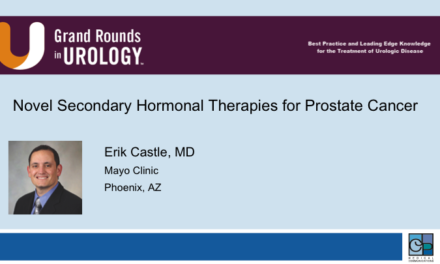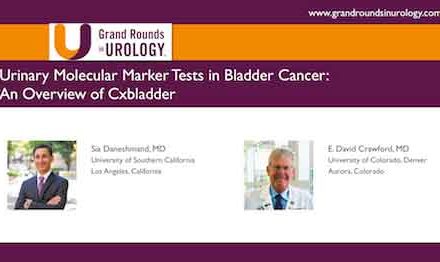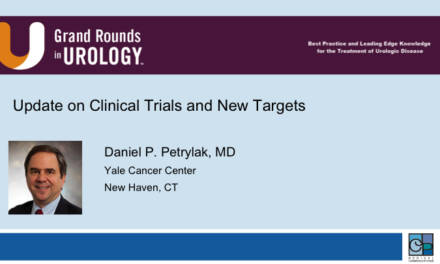Dr. Daniel P. Petrylak, spoke at the 24th annual Perspectives in Urology Point • Counterpoint meeting on Friday, November 13, 2015 on “The Latest on Bone Health and Radiopharmaceuticals.”
Presentation
Keywords
radiopharmaceuticals, bone health
How to cite: Daniel P. Petrylak. “The Latest on Bone Health and Radiopharmaceuticals ” Grand Rounds in Urology. November 13, 2015. Accessed Dec 2024. https://dev.grandroundsinurology.com/prostate-cancer-daniel-p-petrylak-latest-on-bone-health-and-radiopharmaceuticals/.
Transcript
The Latest on Bone Health and Radiopharmaceuticals
So the latest in bone health and radiopharmaceuticals as we know it, it is the predominant source of metastases. These are my disclosures. So what we know is that the bone is the source of metastases and is the common site of metastases. And the important thing is that skill related events are seen in these are complications of the malignant spread. These include fracture, spinal cord compression, the need for radiation therapy or surgery to the bound and also we forget that the patients can become hypercalcemic with prostate cancer. It’s the relative rate of bone lesions and in different cell tumors receive predominately prostate cancer, 90% will develop bone metastases if they development metastatic disease. About half of these developed skeletal related events.
Somewhat lower for lung cancer but still the same frequency, myeloma is actually much, much higher rate – again the same frequency skeletal related events for each of these particular tumors. There’s a dynamic process that goes on in your skeletal system between bone breakdown and bone building. And we know the bone formation occurs osteoblastic elements will express different factors and these will then in turn cause the stimulation of osteoclast will cause bone reabsorption and then there’s an equilibrium that goes on in any normal patient. Mass equilibrium, however, is disrupted in patients with metastatic cancer because there are a variety of different factors secreted by the tumor, including IL-6, which we know creates prostate cancer.
We also know that VEGF agents, which will cause chemotaxis osteoblastic factors as well, will be made by metastatic lesions. And so these can actually again cause difficulty and again we’ll see that predominantly patients in prostate cancer if osteoblastic metastases because those factors the ones the screen by prostate cancer cells. In myeloma, for example, it’s predominately osteoclast or lytic lesions that are seen and the bone areas are different. We know that myeloma will make something called DKK. We also know that singling is also important for the development of metastatic disease. In prostate cancer, and again this is a slide that simply shows the equilibrium from these particular elements.
So bisphosphonates are used often in prostate cancer and there are a variety of different ones that are available. The ones that we’re going to be focusing on today are zoledronic acid and then RANK ligand (RANKL) inhibitor such as denosumab. We know that there are differences between bisphosphonates and RANKL inhibitors. The things we worry about with bisphosphonates include acute phase reactions which include fever, muscle aches and joint pains, which occurs in about 15 to 30% of patients. One of the differences between bisphosphonates and the RANKL inhibitors include renal toxicity because we know these are excreted by the kidney and it can be serious toxicity seen in rare patients.
We also have to monitor our creatinine’s carefully in patients who receive zoledronic acid. We usually don’t give creatinine above 1.5. Another common thing that we see with this particular anti-reabsorptive of agents is osteonecrosis of the jaw. This occurs in about 3% of patients overall and this is basically an area of bone that’s exposed and persists for more than six weeks without evidence of healing. There’s no standard way to manage this particular point. However, early recognition may necessitate the use of surgical intervention, antibiotics, oral antimicrobial rinses follow-up and surgical procedures, as mentioned before, as well are important to the management.
It’s hard to believe but the initial publication of bone target agent shown in clinical benefit was actually about 13 years ago by Fred Sod. He took patients with metastatic castrate resistant prostate cancer, gave them standard of care treatments along with zoledronic acid at 4 mg, initially another and 8 mg, and the third arm had placebo. As we see from this trial in castration resistant prostate cancer, the time to the first on studied skeletal event was superior in the 4 mg arm compared to the placebo arm. In fact the 4 mg arm, which was also derived from the 8 mg arm, also showed the same difference. Now moving forward, as far as other mechanisms of anti-reabsorption are concerned, RANKL inhibition is important. This basically inhibits the osteoblast and osteoclast interaction. And we know the tumor cells will increase levels of RANKL and will decrease expression of osteoprotegerin and this will cause the increased reabsorption of bone through osteoclastic activity.
Denosumab is FDA approved for use in castration resistant prostate cancer. We do see ONG as well as some renal insufficiency with it, but this was approved by the FDA in 2010 for the treatment of castration resistant disease. Again a very similar trial to what we saw from the Fred Sod study. This was performed by Karim Fizazi – randomizing patients with castration resistant prostate cancer to receive either zoledronic acid or denosumab, and the primary endpoint was the development of the first skeletal related event. We see from this slide that this was superior in the denosumab arm by about three months compared to zoledronic acid and there was no difference in overall survival. We saw fewer acute phase reactions, higher rates of hypocalcemia and, for the clinical practice or use of this drug, it’s important they have a normal calcium level before they the start treatment. Because you can develop something called the bone hungry syndrome where there is a rapid decline in calcium when you administer denosumab. And ONJ seems to be slightly higher in those patients who are treated with the denosumab, while this was not powered to look at that particular difference.
Now the one thing I like to point out when we talk about the Stampede trial, is that we should not be using these drugs to prevent skeletal related events in castration sensitive patients. There is no role for using bisphosphonates or denosumab in that situation. If they have osteoporosis, which is a different issue, but there’s no improvement in survival and there’s no delay in progression by using these early. Radioisotopes are important for the management of castration resistant prostate cancer. And they’re basically two different types of particles that have been evaluated over the years. Alpha particles are large in size – imagine this being like a bowling ball. Beta particles are much smaller – imagine the beta particle being a golf ball. The alpha particles consist of healing nuclei and have high levels of energy.
If I took a piece of paper and put it between a Geiger counter and radium 223, you’d find that this does not penetrate. You have a lower level of energy with the beta particles. You need an aluminum plate to halt it and it’ll go right through paper. But most importantly there’s a difference in how it attacks DNA. The DNA hits to kill cells about 1 to 10 for alpha particles; it’s about one 202,000 for the beta particles. Again think of the size. It causes more DNA damage. And this is a double-stranded bit break as opposed to a single-stranded break. Previously there have only been two agents which were beta particles approved for the treatment of castration resistant prostate cancer – samarium 123 as well as strontium 89 – both of these were approved based upon palliative effects. They were not demonstrating improvements in overall survival. Compared to placebo these were placebo-controlled trials but again with strontium and samarium there was improvement in pain.
The trial by Oliver Sartor comparing samarium to placebo showed improvement in visual analog scales. Arthur Porter combined radiation therapy with strontium 89 and found that there was a reduction in the rate of new painful sites and also analgesic free, pain-free survival. And then initially there was a randomized Phase 2 by Dr. Neeson looking at radium 223 compared to placebo. And strangely in a randomized Phase 2 trial, there was a survival benefit but this was not seen with the other beta particles. So this is basically showing us that there is a difference in these particular agents. And one other important factor that is related to the energy of alpha particle versus the beta particle is the radius of activity.
So this is a cartoon of a tumor cell that’s in the bone marrow. This is the bone mineral surrounding it, which is predominately hydroxyapatite. When radium comes into the cell, it basically mimics the areas where calcium is. It’ll kill a tumor in a very small radius. It’s about about the 2 to 10 cell diameters. There’s a much, much greater diameter for the beta particles and this will then pull in normal marrow. And that’s why we tend to see neutropenia as well as thrombocytopenia with the beta particles. So what about randomized trials that further look at radium 223? The ALSYMPCA trial was the pivotal study that demonstrated a survival benefit. Again I have to emphasize the word survival for the use of radium 223 compared to placebo.
So basically there were two groups of patients in the study – those patients who had prior docetaxel and those patients who are unfit for docetaxel. These patients could not have visceral metastases, had to have more than two bone lesions and they have to have confirmed symptomatic prostate cancer. They were stratified based on Alcan phosphatase bisphosphonate use and prior docetaxel. And randomized to receive radium 223 up to six cycles and a placebo and again both arms had as best standard of care. This could’ve included other hormonal manipulations as well. Primary endpoint was overall survival for the study. And the mean age in both arms with 70 predominantly a Caucasian population and about half of patients had more than 20 metastases or super scans. So these were patients with extensive amounts of disease. Patients were well balanced for hemoglobin, albumin and Alcan phosphatase; and the median PSA range between 146 in radium arm and 173 in the placebo arm.
So this is the survival curve for all patients treated on study. The median survival is 15 months versus 11.3 months. It’s been a 3.6 month benefit and overall survival and hazard ratio is 0.695. If we look at the different strata no prior chemotherapy, as one would expect, you see a a better hazard ratio points 0.745 and about a four months 4.6 month difference in the median in favor of docetaxel, in favor of radium in the non-docetaxel treated patients. It goes down to about 3.1 months in those patients who had prior docetaxel. If we look at skeletal related events, there also seems to be a a significant difference in favor of radium 223 by about six months at the median as far as the development of the first goal event is concerned. The hazard ratio is 0.64.
If we look at various components of the skeletal related events, I think the interesting thing about this is there’s actually a reduced rate of spinal cord compressions. And this is to my knowledge the only trial that has actually shown this overall. And that’s actually I think an important factor that follows our quality of life for patients is concerned. Adverse events – interestingly if you look at all AE’s somewhat lower in the radium versus the placebo arm. Grade 3 and 4s again lower, serious AEs is again lower, and discontinuation due to AEs about the same in both arms for radium as well as placebo. The medium number of injections administered was six and the placebo was 5. 63% of patients in the radium arm received all injections. So these are the predominant side effects that were from Grade 3 or 4 – with radium 223 anemia 13% of patients, neutropenia 2%, and the thrombocytopenia which is slightly higher than the placebo at 6.5% of patients.
So if we look at subgroup analysis from the radium 223 trial, we see that overall survival Alcan phosphatase, bisphosphonate use, prior use of docetaxel, baseline ECOG all these will favor radium 223. So how do we put radium 223 in our treatment armamentarium because we’ve looked at two different groups of patients? I think the important thing is the fact that radium 223 does not really seem to influence the other treatments that we administer or at least interfere with them.
So with chemotherapy, this would be the most difficult treatment to administer one would think after radium, because they’re having problems giving chemotherapy after strontium and samarium. So there was a retrospective analysis performed from the ALSYMCA trial looking at those patients who receive chemotherapy after being on study. So 90 of the 615 patients, 15 patients on radium receive chemotherapy and then 54 of the 307 patients in the placebo group, most commonly received docetaxel but some receive mitoxantrone or cyclophosphamide. Patients were well balanced according to age, performance status as well as the Alcan phosphatase levels. And if we look at the platelet counts, very similar in both arms hemoglobin almost dead on for both arms, slightly lower rate of neutrophils were in patients, but it doesn’t of course reach area where we’re concerned about a patient developing neutropenic fevers. And again I think this is basically evidence that you can safely give docetaxel after radium therapy.
What about giving radium therapy upfront to patients? That’s I think a very important issue because again, we like to administer full dose of the drug to secure the bone compartment, we’re actually to finish accrual to randomized Phase 2 trial comparing radium to radium plus abiraterone or radium plus enzalutamide in patients who had never received prior chemotherapy or any of these particular next-generation targeted agents. And the primary endpoint is progression free survival. We’re looking at a variety of different radiographic effects as well, but nonetheless I think this is important because we would like to combine some of our agents and so far we haven’t seen any untoward toxicities. Interestingly, there was a recent publication that looked at a database of patients receiving radium on the expanded access program, and it did seem to be some synergy between some of these agents – such as Abby or enzalutamide where the survival seem to be greater than what you expect with either other agent alone.
Giving chemotherapy is somewhat problematic. This is a publication by Mike Morris at Memorial Sloan-Kettering Cancer Center, where he reduced both doses of radium as well as docetaxel and eventually established 60 mg/m² and 25 KB cues of radium, but giving every six weeks rather than every four and only for two dosages. There were no discontinuations or delays of treatment on the study -10 patients had Grade 3 or normal or four neutropenia. It was predominately in that first group, three patients in cohort 1 and one patient in cohort three, and that’s why the selected cohort 2 for randomized phase 2 cohort but for the time being I think it could be very difficult to administer radium along with chemotherapy.
ABOUT THE AUTHOR
Daniel P. Petrylak, MD, is currently Director of Genitourinary Oncology, Professor of Medicine and Urology, Co-Leader of Cancer Signaling Networks, and Co-Director of the Signal Transduction Program at Yale University Cancer Center in New Haven, Connecticut. He is a recognized international leader in the urology field. He earned his MD at Case Western Reserve University School of Medicine in Cleveland Ohio. He then went on to complete his Internal Medicine Residency at Albert Einstein College of Medicine/Jacobi Medical Center in the Bronx, and his fellowship at Memorial Sloan Kettering Cancer Center in New York.
Dr. Petrylak has served as principal investigator (PI) or co-PI on several SWOG clinical trials for genitourinary cancers. Most notably, he served as the PI for a randomized trial that led to the FDA approval of docetaxel in hormone refractory prostate cancer. He also helped to design and served as PI for the SPARC trial, an international registration trial evaluating satraplatin as a second-line therapy for hormone refractory prostate cancer.
Dr. Petrylak served on the program committees for the annual meetings of the American Urological Association from 2003-2011, and for the American Society of Clinical Oncology from 1995-1997 and 2001-2003. He also has served as a committee member for the Devices and Immunologicals section of the FDA. He has published extensively in the New England Journal of Medicine, Journal of Clinical Oncology, Journal of the National Cancer Institute, Cancer Research, and Clinical Cancer Research.





